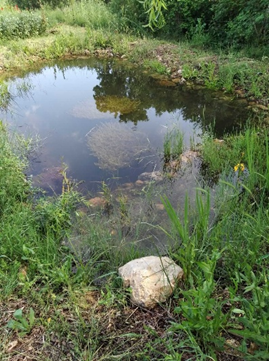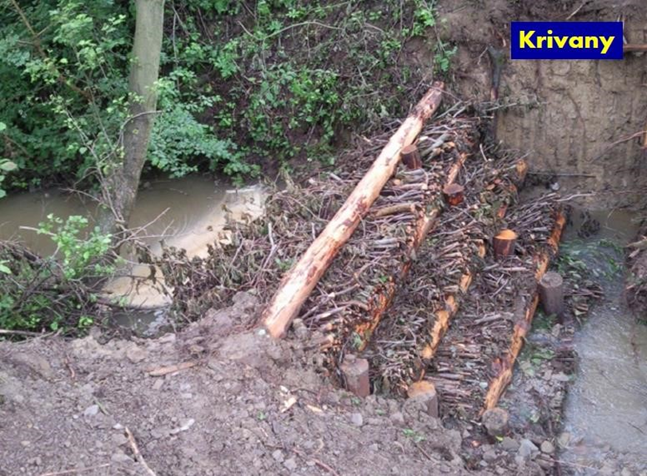- Field corner bunds
- Bunds
- Retention Ponds
- Sediment capture ponds
- Lakelet
Ponds are permanent bodies of water that store surface runoff with additional capacity to hold water during rainfall events. They come in different types, including retention, detention and multi-purpose ponds, sediment capture ponds; shallow impoundments or flood storage reservoirs.
Multi-purpose ponds, which include flood storage ponds and shallow impoundments, serve several functions in stormwater management. These ponds are designed to hold water during dry weather and can store additional water during rainfall events.
We can distinguish online ponds and offline ponds : online ponds sit directly in a stream channel with flow entering and leaving in series through the pond, so they impound both baseflow and stormflow, which can warm water, trap sediment and fragment fish habitat unless carefully designed. Offline ponds are set beside the channel, filled by diverted or overbank flows in parallel to the stream, so they mainly capture high flows, attenuate peaks and treat runoff while leaving low flows and fish passage largely undisturbed, which is why they are often preferred where space allows. Both types can provide storage and water-quality benefits when properly sized and maintained.
Retention Ponds
Retention ponds are typically permanent bodies of water consisting of a permanent basin and landscaped banks that provide additional storage during heavy rainfall events. Retention ponds can be created by using existing natural depressions, excavating new ones or constructing dams. It is important to note that existing natural water bodies should generally not be used for this purpose, as pollution events could damage the natural ecology of the system.
The primary function of retention ponds is to retain storm water runoff and release it after the risk of flooding has passed (see F13 to know more about peak flow control structures), thereby reducing the likelihood of flooding. They provide both storm water attenuation and water quality treatment. Retention ponds are designed to capture runoff from all storm events and treat it as it is retained and stored in the pond.
The retention time and stagnant water within the pond facilitates the removal of pollutants through sedimentation. In addition, aquatic vegetation and biological processes contribute to the treatment of runoff pollutants.
A typical retention pond design includes several key features:
A sediment forebay or other pre-treatment systems to capture and treat runoff before it enters the main treatment zone,
A permanent pool that remains wet throughout the year and acts as the primary treatment zone,
A temporary storage volume for flood attenuation created by landscaped banks surrounding the permanent pool,
A shallow zone or aquatic bench along the edge of the permanent pool that supports wetland or riparian vegetation plantings and provides ecological, amenity and safety benefits.
Proper design and maintenance of retention ponds is essential to their effectiveness. They can also enhance the aesthetic and ecological quality of urban landscapes, serve as attractive public open spaces and support emergent and submerged aquatic vegetation along the shoreline.

Illustration: a retention pond in forest (FR)
Source: Permalab project
Sediment capture ponds
Sediment capture ponds are specifically designed to trap and remove sediment from runoff. Sediment capture ponds are engineered ponds placed in networks of forest ditches to slow the velocity of water and cause the deposition of suspended materials. Sediment capture ponds are most useful for managing the effects of ditch construction and maintenance, road work and final feeling. While used primarily in forests, sediment capture ponds may be a useful temporary measure for preserving water quality in and around construction sites or mines. They may also be useful for capturing sediment in agricultural runoff. Sediment capture ponds have a limited lifespan, depending on how much suspended material is in the inflowing water. However, ponds can be maintained by removal of accumulated sediment. As most water protection methods, sediment capture ponds function well during base and moderate flow events. Catchment area, hydraulic properties of ditches, discharge rate and soil characteristics are among factors influencing functioning of sedimentation capture ponds. Effective functioning largely depends also on expertise and skill of professionals designing and implementing this and also many other measures.

Illustration: sediment capture pond (SK)
Source: Michal Kravcík’s presentation, NWRM Workshop 1 (SVK)
Field corner bunds
Field corner bunds are small earthen embankments placed at low points of agricultural fields, typically in corners or margins where overland flow concentrates, to create temporary offline storage that slows runoff, traps sediment and nutrients, and releases water slowly through a spillway or pipe once peak flows subside. They are classed within the wider family of runoff attenuation features and Rural SuDS, with design keyed to locating fast flow pathways and using local soils to form compacted bunds that impound shallow water for short periods before draining, thereby reducing flood peaks and diffuse pollution while taking little land out of production. Compared to other ponds, they have an heavy focus on runoff attenuation in corners and depressions.